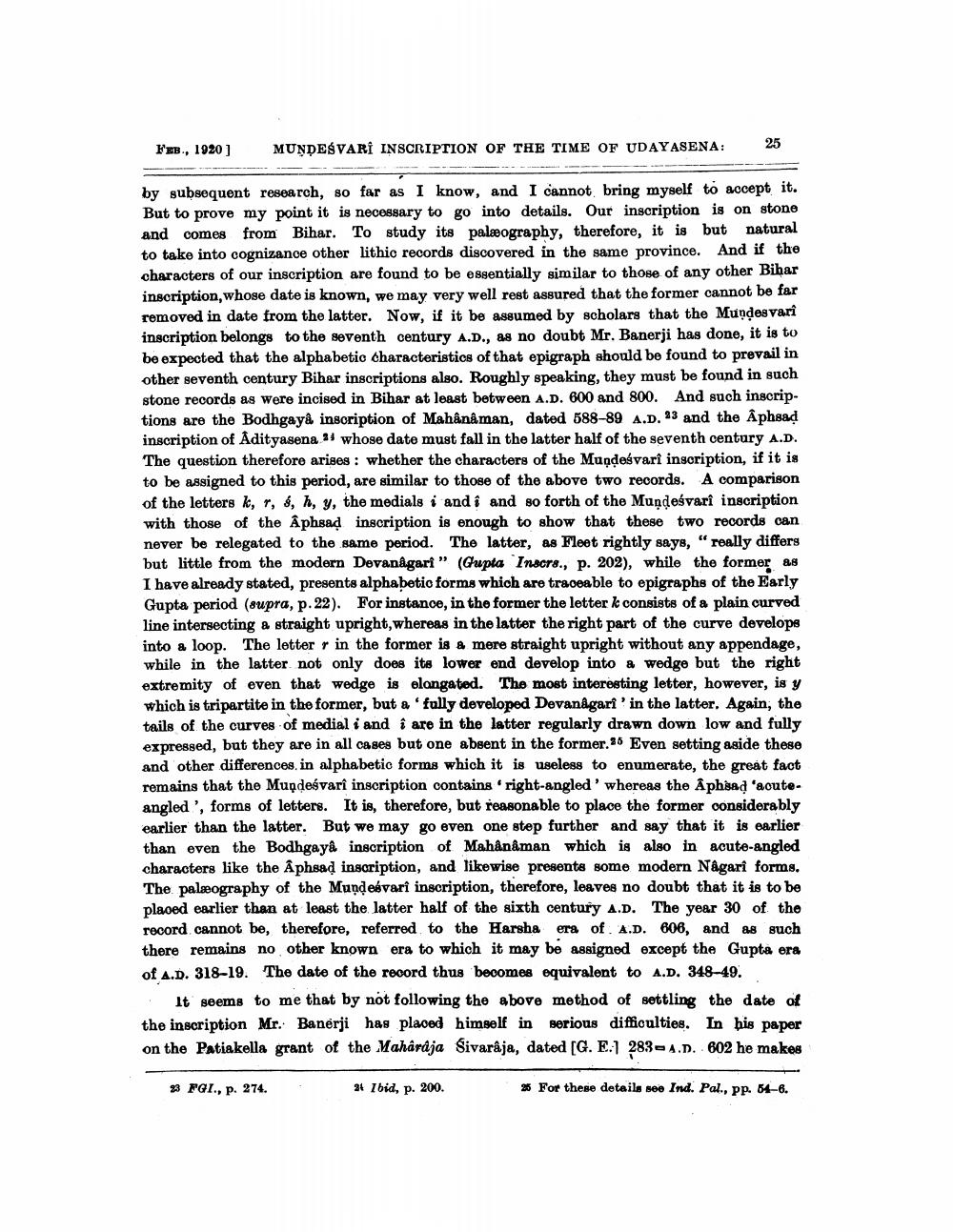________________
FEB, 1920]
MUNDESVARI INSCRIPTION OF THE TIME OF UDAYASENA:
25
by subsequent research, so far as I know, and I cannot bring myself to accept it. But to prove my point it is necessary to go into details. Our inscription is on stone and comes from Bihar. To study its palæography, therefore, it is but natural to take into cognizanoe other lithic records discovered in the same province. And if the characters of our inscription are found to be essentially similar to those of any other Bihar inscription, whose date is known, we may very well rest assured that the former cannot be far removed in date from the latter. Now, if it be assumed by scholars that the Mundesvari inscription belongs to the seventh century A.D., as no doubt Mr. Banerji has done, it is to be expected that the alphabetic characteristics of that epigraph should be found to prevail in other seventh century Bihar inscriptions also. Roughly speaking, they must be found in such stone records as were incised in Bihar at least between A.D. 600 and 800. And such inscriptions are the Bodhgay& insoription of Mahânâman, dated 588-89 A.D. 93 and the Aphsad inscription of Adityasena 21 whose date must fall in the latter half of the seventh century A.D. The question therefore arises : whether the characters of the Muqdegvari inscription, if it is to be assigned to this period, are similar to those of the above two records. A comparison of the letters k, r, , h, y, the medials i and i and so forth of the Mundeśvari inscription with those of the Aphsad inscription is enough to show that these two records can never be relegated to the same period. The latter, as Fleet rightly says, "really differs but little from the modern Devanagari” (Gupta Inscrs., p. 202), while the former as I have already stated, presents alphabetic forms which are traceable to epigraphs of the Early Gupta period (supra, p.22). For instance, in the former the letter k consists of a plain curved line intersecting a straight upright, whereas in the latter the right part of the curve develops into a loop. The letter in the former is & mere straight upright without any appendage, while in the latter not only does its lower end develop into a wedge but the right extremity of even that wedge is elongated. The most interesting letter, however, is y which is tripartite in the former, but a 'fully developed Devanagari' in the latter. Again, the tails of the curves of medial i and i are in the latter regularly drawn down low and fully expressed, but they are in all cases but one absent in the former.36 Even setting aside these and other differences, in alphabetic forms which it is useless to enumerate, the great fact remains that the Mundesvari inscription contains right-angled' whereas the Aphsad 'acuteangled ', forms of letters. It is, therefore, but reasonable to place the former considerably earlier than the latter. But we may go even one step further and say that it is earlier than even the Bodhgaya inscription of Mahåndman which is also in acute-angled characters like the Åphsad inscription, and likewise presente some modern Någari forms. The palæography of the Mundesvari inscription, therefore, leaves no doubt that it is to be placed earlier than at least the latter half of the sixth century A.D. The year 30 of the record cannot be, therefore, referred to the Harsha era of. A.D. 606, and as such there remains no other known era to which it may be assigned except the Gupta era of A.D. 318-19. The date of the record thus becomes equivalent to A.D. 348-49.
It seems to me that by not following the above method of settling the date of the inscription Mr. Banerji has placed himself in serious difficulties. In his paper on the Patiakella grant of the Mahârâja Sivarâja, dated [G. E.1 283A.D. 602 he makes
23 FGI., p. 274.
34 Ibid, p. 200.
* For these details seo Ind. Pal., pp. 54-6.




